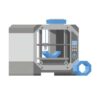3D Printed Orthopedic Implants Market Summary:
Orthopedic implants are used to replace or support damaged bones and joints, and 3D printing has revolutionized the manufacturing process, allowing for more precise and customized implants. The 3D printed orthopedic implants market has witnessed significant growth in recent years, thanks to advancements in technology and the increasing demand for personalized medical solutions. One of the key advantages of 3D printed orthopedic implants is their ability to be tailored to each patient’s unique anatomy. Traditional implants are often one-size-fits-all, which can lead to complications and discomfort for patients. With 3D printing, implants can be designed and manufactured to perfectly fit the patient’s specific needs, resulting in improved outcomes and faster recovery times. Furthermore, 3D printing allows for the creation of complex geometries that were previously impossible to achieve with traditional manufacturing methods. This opens up new possibilities for designing implants that are not only functional but also mimic the natural structure of bones and joints. By closely replicating the patient’s own anatomy, 3D printed implants can provide better stability and integration with the surrounding tissues.
The market for 3D printed orthopedic implants is expected to continue growing in the coming years. The aging population, coupled with the rising prevalence of orthopedic conditions such as osteoarthritis and fractures, is driving the demand for innovative solutions. Additionally, the cost-effectiveness and efficiency of 3D printing technology make it an attractive option for both patients and healthcare providers. The 3D printed orthopedic implants market is experiencing rapid growth due to its ability to provide personalized and precise solutions for patients. With advancements in technology and increasing demand, this market is set to expand further, revolutionizing the field of orthopedics and improving patient outcomes.
3D Printed Orthopedic Implants Market Overview:
The 3D Printed Orthopedic Implants Market overview provides a comprehensive understanding of the analyzed market. It includes an introduction to the market, its size, growth rate, and key trends. This aims to give clients a broad understanding of the market landscape. The market analysis of the 3D Printed Orthopedic Implants Market delves deeper into the market dynamics, focusing on factors such as market drivers, challenges, and opportunities. It explores the macroeconomic and microeconomic factors affecting the market, industry regulations, and emerging market trends. The analysis provides valuable insights into the current and future market conditions.
The assessment of the 3D Printed Orthopedic Implants Market is performed by taking various factors into consideration, like, for instance, the business expansion policies of key players, competitive analysis of the progress of new entrants and emerging players, and the revenue, financial, and opportunity analysis of market players. The also analyzed based on regional segmentation, type or technique, end-user spectrum, etc. This research implements the latest methodologies to help clients understand the overall market scenario and strategize accordingly. The 3D Printed Orthopedic Implants Market report provides an overview of the different types of analysis conducted during the market research process, including but not limited to SWOT analysis, Porter's Five Forces analysis, PESTLE analysis, and market forecasting. These analyses provide a deeper understanding of the market dynamics and assist in making informed business decisions.
Major players included in the 3D Printed Orthopedic Implants Market:
- 3D Bioprinting Solutions
- Rokit
- Aspect Biosystems
- BioBots
- Cyfuse Biomedical
- Formlabs
- Medprin
- Organovo.
- EOS
- General Electric
- Stratasys Ltd.
- Materialise N.V.
- Renishaw plc
- Evonik Industries
- Medtronic Plc
3D Printed Orthopedic Implants Market Segmentation:
By Implant Type
- Cranial/Facial Implant
- Spinal Implant
- Hip Implants
- Knee Implants
- Extremities Implants
By Technology
- Powder Bed Fusion
- Vat Photopolymerization
- Material Extrusion
- Others
By Material Type
- Metal
- Polymer
- Plastics
- Others
By End-User
- Hospitals
- Ambulatory Surgical Centers
- Orthopedic Clinics
- Others
Future Market Analytics Focus Points:
- SWOT Analysis
- Key Market Trends
- Key Data -Points Affecting Market Growth
- Revenue and Forecast Analysis
- Growth Opportunities For New Entrants and Emerging Players
- Key Player and Market Growth Matrix
3D Printed Orthopedic Implants Market Competitive Analysis:
The competitive analysis of the 3D Printed Orthopedic Implants Market assesses the competitive landscape of the market. It includes evaluating key players in the industry, their market share, business strategies, and competitive advantages. The competitive analysis also highlights the strengths and weaknesses of major competitors, allowing clients to understand the competitive positioning of companies operating in the market.
Objectives of the Study:
- To provide a comprehensive analysis on the 3D Printed Orthopedic Implants Market by segmentation and by region
- To cater extensive insights on factors influencing the market growth (drivers, restraints, industry-specific restraints, business expansion opportunities)
- To anticipate and analyse the market size expansion in key regions- North America, Europe, Asia Pacific, Latin America and Middle East and Africa
- To record and evaluate competitive landscape mapping- strategic alliances and mergers, technological advancements and product launches, revenue and financial analysis of key market players
How our market research reports help clients:
Our market research reports provide valuable insights to clients in their decision-making process and support their growth and market capture efforts. They offer:
- Comprehensive understanding of market trends, dynamics, and growth potential.
- Identification of niche markets and emerging opportunities.
- Assessment of competitive landscape and strategic benchmarking.
- Insights into consumer preferences, buying behavior, and market demand.
- Risk assessment and mitigation strategies.
- Market forecasting and trend analysis for informed business planning.
- Understanding product development, pricing, and other strategies.
In case of any specific requirements or changes to the current table of content based on your scope, please contact us at: enquiry@futuremarketanalytics.com






















